From Max Popenker, we have a set of photos of a very funky German submachine gun from the first world war (presumably 1918). The weapon is currently in possession of the weapon design department at Tula State University in Russia, and that’s where these photos were taken. Until now, the only photo available of this gun was this one (and it has some minor differences from Tula’s example, including the front grip and oil bottle in the stock):
Well, it turns out that the gun in that picture is missing its feed box, which is a pretty important part, and tells us a lot about how it worked. The gun actually fed from a multi-column clip which held 8 rows of 10 cartridges each, somewhat like a cross between a 1914 Fiat-Revelli and a Japanese Type 11 LMG. When first loaded, the first column of cartridges is engaged by a sort of rack and pulled up to the chamber one by one. After the 10th round is chambered, the entire clip is stepped to the right so that the second column of cartridges is in position to be fed upwards. When all the rounds have been fired, the now-empty clip is pushed out through a slot (with its own spring-loaded dust cover) on the right side of the feed box.
The action of the gun itself is based on the Maxim MG08/18 air-cooled machine gun, using the same type of recoil-operated toggle lock, just scaled down to a the 9mm Parabellum pistol cartridge. Instead of having the recoil (fusee) spring on the outside of the gun, in this case it is located inside the buttstock, like many other more modern designs.
Pretty much nothing else is known about this gun, including who made it, exactly when, whether it ever saw field use, how many were made, and whether or not it actually worked effectively. Heck, I don’t even know what the proper name of it is…but it certainly is interesting and unusual. Thanks, Max!

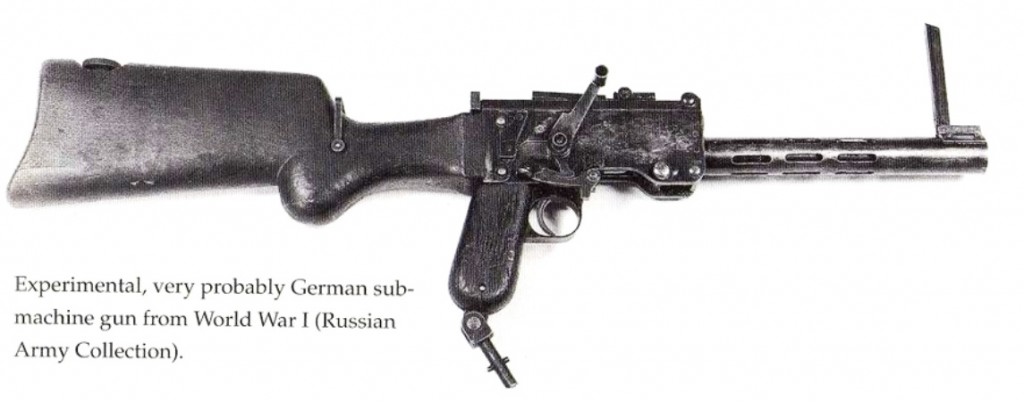

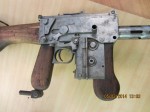
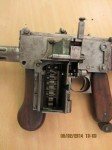
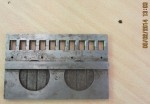
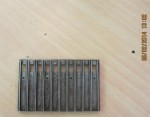
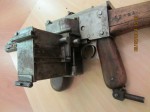

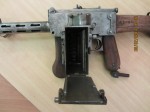

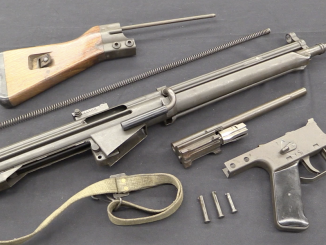
At first glance i think that this gun is from post-apocalyptic movie or game, but on the other hand it is also steam-punk looking.
Note that this gun is designed also to provide more controllable full auto fire.
It would have been an appropriate prop for the “John Carter” movie.
Ian, this gun fires 9×19 PPatr.08.
Any info on how much it weighs? Will you put any other data you have on it on your excellent website? In any case, many thanks!
That gives us a constraint for its earliest possible date.
The magazine looks quite large for a single 9mm round, it looks as if two could fit on each “tray” perhaps.
I say “tray” meaning the columns…
it’s a bunch of stripper clips attached to a backplate
That is cool, Many thanks to Max for sharing it with us.
Daweo has already pointed out that the gun is adaptated for controllable automatic fire (inline layout and is that a swivel for mounting – aircraft? or ground position – perhaps in the role occupied by artillery lugers? or perhaps for supply crews?
It is tempting to draw analogies to “missing link” fossils, such as ground or tree dwelling dinosaur fossils with feathers, or archaeoptrix a feathered bird with clawed fingers on its wings and teeth in its mouth,
but that would be to ignore that the fossils were of critters which had successfully exploited ways of living, better than anything around them had up to that point.
Guns like this are exploring possible applications, for which there are probably better solutions too
and there may also be better applications for the gun too.
Like the roughly contemprary Villar – Perosa, this looks to be an attempt to scale down the conventional machinegun, complete with attachment to a tripod or other fixture, however the stock on this one does suggest that a more mobile use was also anticipated, but hardly to the highly mobile trench raiding and house clearing which evolved in conjunction with the more developed SMGS.
This is such a wonderful little gun and a link to such an interesting time in the development of guns.
Good observation! Is that a pintle mount under the wood pistol grip?
A very bizarre gun. Ingenious, certainly, but bizarre. Very “steam punk” indeed!
It certainly looks like a pintle mount rod. Coupled with the sling bar on the left side of the barrel cooling jacket, and the fact that it has that cooling jacket, I’m almost inclined to think that it was originally intended as an “observer gun” for aircraft.
If so (and I don’t insist on it), the actual model number might be more like “08/15”. By 1916 the Germans had pretty much abandoned the idea of pistol-caliber MGs in aircraft, but they were considered a viable concept as late as mid-1915.
The sling would probably have been intended for attachment to a harness worn by the gunner to steady the gun in the slipstream.
Just a guess.
cheers
eon
A good theory, but the front grip suggest that ground use was envisaged as well.
The front grip would be equally as useful in a mounted setup given the placement of the pintle.
With a high AA ring sight in a small aircraft cockpit or observer position? I can’t see how it would be useful.
EW;
A lot of flexible guns had a post front and notch rear, much like a ground gun. This was especially true of guns with shoulder stocks, which were fired in a stance much like a normal rifle. The flexible Lewis gun was one example.
This weapon’s sights would be consistent with that practice. Or ground use, as you point out.
cheers
eon
Yes, you are right that especially early on many observer MGs had ground style sights, so if this really is a 1915 development, it would fit. Regardless, I still can’t see any use for the front grip in aircraft use.
EW;
Early on, observers learned that it generally takes both hands to control a “single” flexible gun in the air, less from recoil than the slipstream trying to “push” the gun around. The second grip up front would be for that use, especially because having the pintle mount on the main pistol grip doesn’t give the gunner very good leverage at the rear. Compare this setup to a single Lewis or Vickers VGO on a Scarff ring, and you can see the difference.
This design, if intended as an aircraft flexible gun, should have had a Lewis or Parabellum-type mount at the front of the receiver. Then again, in 1915 they didn’t know that yet, as aerial gunnery of all types was in its infancy.
This could have been one of the experimental designs that, when tested in actual aerial trials, showed them the right way to mount such a weapon, by making the drawbacks of this setup obvious.
cheers
eon
Yes, it suppose it might be somewhat useful, although I would think holding onto the shoulder stock with your left hand would probably be as good if not better. Also, why the shoulder stock if the gun was designed for aircraft use? The Villar-Perosa had spade grips, which in my opinion would make much more sense. Later Lewis AA and flexible aircraft variants also dispensed with the shoulder stock and replaced it with a spade drip.
Well spotted about the barrel jacket.
Adding water cooling, complete with a condenser can would take the steam punk to an even higher level than this lovely little gun has already achieved.
Does anyone have an indifference engine to do the indirect fire calculations?
“It is tempting to draw analogies to “missing link” fossils,”…Boy Keith, you said it, and nailed it.
Thank you all for bringing another amazing anachronism out into the light!
Note that for some reason the drum (Trommel) magazine of Luger pistol was not used. Do you know reason to rejection of drum magazine?
The Trommelmagazin 08 wasn’t all that reliable in feeding, as the German Army learned when they tried to use it on the Bergmann MP18 SMG. (Note how fast it was replaced by a proper “box” magazine on the MP18.1 aka MP28 version after the war.)
Also, it would have stuck out much further on the left side, with most of its weight in the “drum” section, thereby overbalancing what was probably a pretty cranky handful to manage to begin with.
Also, I’d expect a weapon like this, with a lightweight bolt/toggle assembly and short travel, to have a very high rate of fire even in 9x19mm PPatr.08. Probably roughly equal to that of the original Ingram-designed MAC 10 SMG in 9x19mm, or about 1,100 rounds per minute.
I can personally attest to how fast a “Mac Ten” can empty a 32-round magazine on full-auto, having done it a time or two. You just about get your wits collected enough to let up on the trigger when it goes dry, until you learn to “tap” the trigger to generate five-or-six-shot bursts. It’s much easier with an MP5 (even without a three-shot burst control on the trigger group), and dead easy with an MP 38/40, M3, Thompson M1928 or M2 Carbine, as they all have lower ROF. (Been there, done that.)
The large-capacity “Gardner”-type magazine of this widget was less of a problem as a weight on the left side due to being closer to the bore axis. And holding at least 80 rounds, allowed a decent number of bursts between reloads, which were apparently automatic anyway, with two “trays” in a loaded box giving 160 rounds total. At MAC 10 fire rates, that’s about eight or nine seconds’ worth of fire at 18 rounds/second.
Not a bad ROF for an aerial gun, actually. Almost up to the “twinned” Gast gun system (1,600 rounds/minute) of 1918. And with the slipstream and barrel jacket, plus the lower heat transfer of 9x19mm, barrel heating would have less of a problem than with the later rifle-caliber weapons.
cheers
eon
Cool man, it looks like the “machineguns” we created as a kids in uncle’s garage from scrap metal and firewood.
omg,…
… doesn’t it though?
I like the magazine, a form of it might be ok in kind of:
http://en.wikipedia.org/wiki/Heckler_%26_Koch_G11
If it was mounted in the G11’s manner…
The feed hopper setup reminds me irresistibly of a Nordenfeldt or multiple-barrel Gardner. Basically their system turned on its side and given a spring-power option.
It also has some elements of both the Revelli M-1914 and the Japanese Type 11 (1922) MGs, the latter using a hopper feed that took the five-round stripper clips for the Type 38 (1905) Arisaka bolt-action rifle.
Exactly why Mauser would have come up with such a feed setup at that time, when they were already using fabric feed belts on the MG.08, is a very good question.
It might be another indicator that the gun was intended as an aircraft-mounted weapon. At the time, the German Army was concerned with loose belts being a problem in an airplane in flight. Mainly being thrown about by the slipstream and hitting the crew or a sensitive part of the airplane’s structure- like a fabric-covered wing or tailplane, for instance.
The “feed blocks”, by comparison, could be ejected through the slot in the right side of this weapon’s receiver and caught by a collector bag, more or less like ejected cartridge cases could be caught by a “brass-catcher” bag. This would keep them from being whipped backward by the slipstream and possibly damaging the aircraft’s empennage.
Again, just a guess.
cheers
eon
Aircraft, pivot mount etc seems apt… Rear gunner or something, 9mm underpowered for aircraft… Possibly a model, with the notion to make something bigger. Bet a rear gunner in WW1 would have liked an An94, just saying he he.
That large foresight would suggest it wasn’t for firing from the hip also…
Hi Pdb
I think I might have an explanation as to why an aircraft weapon (assuming that’s what this is) was chambered for such an inappropriate calibre
Basically there was a point in WWI when the need to arm the aircraft with an automatic weapon was widely known but due to weight constraints the pilots were very limited in what they could carry. There’s this anecdote I remember about a member of the R.F.C who took a Lewis gun up with him, the weight of the gun and ammunition meant that he took a whole hour to reach operational height on landing he was told to ditch it because of the damage to performance
Eventually engines got more powerful so you could mount rifle calibre machine guns on the aircraft but for a time I think a pistol calibre machine gun would have been considered better than just a rifle. I thought the Italians were the only ones to actually build one, never knew the Germans had experimented with the concept until now.
Early on, the Austrian Army Air Service experimented with Steyr M1911 9×22.8mm automatic pistols with extended (fixed) 16-shot magazines for air use. And the Royal Naval Air Service did likewise with M1911 Colt autos in .455in Webley Self-Loading caliber, with 20-shot magazines and “brass-catcher” cages attached to the right grip. (Smith, Small Arms of the World, 9th ed. [1969], p.149.)
As you state, weight was the main factor. But once more powerful aero engines like the Hispano and Oberursel came along in late 1915 and early ’16, the rifle-caliber machine guns rapidly superseded the pistol-caliber weapons, not to mention the side-by-side shotguns some early pilots favored.
At least one technical drawing exists of a twin Villar-Perosa built to take the Italian 6.5mm Mannlicher-Carcano cartridge. This may have been an experimental model; intended to “spike it up off its knees” and give it the range and power an aircraft flexible gun needed to begin with. And blowback or retarded-blowback rifle-caliber MGs were not unknown at the time, such as the Austrian Schwarzlose, Italian S.I.A., etc.
(In fact, both of those survived into WW2, along with several straight-blowback training LMGs used by the Japanese Army with reduced-charge 6.5mm Arisaka; the latter showed up in NKPA and Chinese PLA hands in Korea.)
AFAIK, no “rifle-caliber” VP was ever built, but the drawing shows that the idea was at least considered.
Oh, and BTW, the British Royal Flying Corps, always pound-phobic, issued Roth-Steyr M1907 8mm auto pistols to some of its pilots early in the war. Exactly where and how they came by them would be interesting to find out. The R-S, of course, had a searage and trigger action that was a forerunner of the modern Glock-type “Safe Action”.
cheers
eon
Rather, chocks away! Chaps 🙂
Early AN94, two rounds in each column, one feeds, fires barrel moves back with toggle, toggle opens ejects the other fires before the barrel returns…
The first one in the column.
“Don’t know just a theory”
On the premise, the magazine looks over sized for a single 9mm round.
The rack thing, a sort of Treeby chain gun magazine mechanism is it… One round in front of the other, per rack lug if you will “said lug being in the middle of both rounds in each column”
Then the second, which is already positioned behind the magazine position if you follow me.
Ahem, cough… Er, I had assumed the round/s laid in the columns, laid flat, and you had multiple clips stacked on top of each other which moved across and up. Think that’s because I thought of the G11 straight away and imagined the rounds be as above per column but falling vertically into said Hk weapon, then the next clip. From this misperception, I thought two rounds per column one laid in front of the other.
Oh great, just what I need. Another wildly strange gun that I can obsess over trying to figure out exactly how it works.
While on first glance this does look a lot like a MG08/15, it does appear to be quite a lot more than just a scaled down version of the action.
First of all, the gun is upside down (compared to a MG08). It looks like the ejection port is above the barrel, and the charging handle is forward while the bolt is closed (like on a Vickers)
Also, the MG08, like other Maxim guns, had a two stage feeding system where it would pull back the cartridge from the belt, put it in line with the barrel, and chamber it. This meant that the belt was located directly above the barrel. This SMG appears to be feeding from well behind the barrel, so it must be feeding the cartridge from the clip to the bolt once the bolt is at it’s rear most position.
Well you appear to know more about Maxims, guns etc than I C.Oelund so how does what you just said fit with what I suggested i.e. Think a Swiss Lmg25, but with two magazines… Barrel forward, chamber a round with the toggle, fire, barrel moves back with toggle, toggle opens ejects, toggle inline with rear magazine, toggle loads from this fires, rest of sequence similar to an An94 in away I know not what.
The magazine box is definitely not big enough to have two rows of cartridges.
I think it looks bigger than it actually is. The rear most part of it has room for the clip (which looks to be very thick), and the front of the box has what looks to be the clip-shifting feeding pawl that pushes the clip sideways once a row is empty.
So if you subtract those two empty spaces there really is just room for one clip.
You can also see this by the feeding comb at the end of the feeding box. If you look at the diameter vs length of each of those slots you can see that those match the dimensions of a single row of 9mm cartridges.
The Maxim guns have a recoil barrel. It is the recoiling movement of the barrel that breaks the toggle link and causes the gun to cycle. If you look at the picture of the right side of the gun, you can see a slot which the charging handle is sticking out of. this slot shows you how much the barrel is moving back every shot.
These clips does not allow the cartridges to be stripped forward (like from a magazine or a en-bloc clip) so the feeding mechanism will have to strip the round upward.
One way it could work is that it feeds it directly on to the breechface, since this looks like a more or less traditional Maxim design. This type of bolt does not have an extractor claw or ejector like you see in most other weapon designs. The breech face is a rail that the cartridges can slide into (muck like how the are held in a clip). The cartridge is held in place by the rail cutout in the breech face. once it’s fired the breech face is retracted, pulling the casing along with it. When it’s at the rear the breech face is raised putting the empty casing in line with the ejection port and a new cartridge in line with the chamber. the bolt moves forward poking the empty casing through the ejection port and the fresh cartridge into the chamber. Once fully forward the breech face slides down, releasing the empty casing (which drops out of the ejection port) and putting the fresh cartridge further up on the breech face.
(This is how it would work in a traditional maxim)
As for this SMG, this sort of feeding would be rather difficult because of the rearward placement of the feeding box. It would have to put the cartridge on the breech face while the bolt was moving backwards and before the breechface is lifted.
Another possibility is that it first strips a cartridge upward, then as the bolt moves forward it pushes this freshly stripped cartridge forward underneath the barrel. Then when the breechface is lowered (following the chambering of the previous cartridge) the bolt face would slide over the rim of the next cartridge.
This would give the cartridge a very interesting trip in the cycle of operation.
First it would be pushed upward from the clip, then it would be pushed forward underneath the chamber. Then it would be retracted and lifted up in line with the barrel and pushed forward into the chamber, once fired it would then be retracted again and lifted up in line with the ejection port before being pushed forward through the ejection port where it would finally be released by the breech face.
I’d like to stress that I’m just speculating here, and guessing how this could work based on these photos. I have no other evidence to go with so don’t take my word for it that this is how it actually works. (but do feel free to contribute to the speculations)
Hmmm, well… Well done for conceiving the “in out shake it all about” mechanism you allude to anyway he he 🙂
Aye, I think you have it about right C.Oelund. I should have looked at that Fiat gun first…
Maxims have recoiling barrels right? Via recoil booster, what’s that clump thing on the end of the barrel the foresight is attached to…
Barrel jacket…
That’s a very interesting point.
I was wondering earlier about the ability of 9mmp to both operate the short recoil system of this gun (there’s probably too little pressure left at the muzzle for a recoil intensifier to make any real use of it, especially as it needs to have room for a bullet that is .355″ diameter to get through, compared to .308 to .323 for a full size rifle case – even compensators on SMGs were more trouble than they were worth)
and not only to operate the recoil system but to index the feed trays as well!
I gather that there were some heavier loads for artillery lugers and luger carbines, I wonder whether this also required heavier loads, or whether the toggle geometry was adjusted place the pivots closer to a straight line than in the Luger and Borchardt pistols, to make for easier breaking of the toggle lock?
What if it was a “fancy” one, like off an An94… Just saying, what if? He he.
I think it’s 7.92 Mauser now.
@ Max Popenker & Ian McCollum :
Many thanks for enlightening us on yet another of history’s unknown but wonderfully interesting prototype military weapons. Would it be too much to ask if the curators at Tula State University — via the good offices of Max Popenker — would be willing to provide further information on this particular gun and its history?
On another note, I cannot help but think that here on FW, many members of this blog have consistently forged friendships based on mutual interests which have expanded into stronger ties and a deeper understanding without diluting our respect for hard truths and facts, or failing to learn and appreciate and accept our many differences for that matter. I think a lot of this is based on simple openness and honesty, which is a truly wonderful thing. If only the politicians and other sanctimonious influential parties that dictate our everyday lives and relationships at a national and international level could understand this plain truth as so many on FW seem to do.
And I should add respect, regardless of differences, into this equation. In summary, real “give and take”, instead of always seeking the better end of a deal ( or argument ) vis-a-vis the other guy.
Thanks for posting this; it’s certainly something I never even knew existed before
Reading the comments on this site is an education in of itself; going by just the pictures I would personally have just assumed it was an over engineered smg and known nothing else. Having read the comments I’ve now got a pretty good idea of everything from how the loading mechanism might have worked to why the weapon was created in the first place.
I did have a thought about a way you could make a rough guess as to whether the weapon had seen any use in the field. Basically does anyone know the rough date when the weapon was acquired by Russia?
If the weapon was acquired during WWI you could make the assumption that the example on display in Tulsa must have been present close enough to the frontline for the Russians to capture it and therefore might have been undergoing combat trials or something when it was captured. Obviously if it was acquired after or during WWII the weapon was probably found in a collection somewhere and sent back to Russia when the Red army was rolling through Nazi Germany and so would have been less likely to see any frontline use.
It could also have been acquired in 1919-20, when all of the victorious Allied powers were scouring Germany for weapons technologies, much as they would do again in 1945-46. (Yes, even the Russians, in spite of fighting a civil war at the time.)
The difference was, the first time around, most of the “good stuff” was already on its way to front companies in the Netherlands, Switzerland, and elsewhere within weeks or even days after the Armistice. In fact, some of it left even before the last shot was fired at 1159 hrs Paris time, 11 November 1918. See The Machine Gun, Vol. 1, by George Chinn, and/or The Guns of the Third Reich by John Walter.
cheers
eon
There is also the possibility that the first picture is incorrectly labeled and the gun isn’t German nor from the first world war. The phrase “Very probably” doesn’t exactly sound confident.
Most sides of the war used the Maxim, or a variation of it, so this wouldn’t be a technology that needed to be acquired from the Germans after the war.
The reason I’m beginning to think that it might not be German is that the pistol grip is quite different from the MG08/15 and /18, but the stock however does sort of resemble the stock seen on the Maxim-Tokarev.
Thanks for the reply Eon
I’d always just assumed that the Russians didn’t have any presence in Germany post WWI.
Assuming the weapon is German it must have a very interesting history even if it didn’t see combat use, changing hands from the Germans to the White Russians and then to the Reds.
I suppose we’ve got the Russian civil war to thank for the lack of documentation on the weapon’s origins.
Ian, how can I keep the ads on the right side from obscuring part of the pictures and text?
Looking at the magazine clip, it has a rail running along its length horizontally. This rail, fits into a slot in the magazine housing. Which means the rounds in the columns, or a round sit vertically in the magazine?
Wait a minute, clips… You know normal ten round ones which you load Sa80 mags with, this guns magazine is a big clip. The columns must be lips to hold the rounds rim, you slot the cartridges in vertically so each column holds 10 rounds, ten columns means it holds 100 rounds. It’s rack thing engages one column at once, from the bottom pushing the rounds in that column up towards the chamber. When that column is empty, the magazines clip slides horizontally so the next column is inline with the rack.
I don’t think its 9 Luger.
“The gun actually fed from a multi-column clip which held 8 rows of 10 cartridges each, somewhat like a cross between a 1914 Fiat-Revelli and a Japanese Type 11 LMG. When first loaded, the first column of cartridges is engaged by a sort of rack and pulled up to the chamber one by one. After the 10th round is chambered, the entire clip is stepped to the right so that the second column of cartridges is in position to be fed upwards. When all the rounds have been fired, the now-empty clip is pushed out through a slot (with its own spring-loaded dust cover) on the right side of the feed box.”
Is that what Ian said, but the clip has ten rows holding say 8 cartridges in each row stacked vertically.
Ha, when I said vertically originally there I meant with the bullets pointing at the floor.
After careful consideration I still don’t think this gun was designed primarily for aircraft use. The shoulder stock and front grip are unnecessary and in fact detrimental in such use; for example the Villar-Perosa had spade grips. My theory (or rather hypothesis) after reading the various comments here is this:
The German army in WW1 didn’t have a true LMG like the Chauchat and Lewis. Even the MG 08/18 was more a medium machine gun on a bipod than a true light machine gun (similar to the WW2 RP-46 and M1919A6). The MG 08/18 and its crew probably had problems keeping up with the maneuvering elements.
Therefore, the weapon in question was designed the fill the “gap” in automatic weapons between the MG 08/18 and MP 18. It could be fired from the hip while advancing and the large “magazine” provided sufficient firepower for suppressive fire. 9x19mm Luger is good enough for providing suppressive fire up to 250 meters when fired from a long barrel. I don’t know the barrel length but it seems to be at least 250mm (≈10″), which would be enough for that purpose. The presence of the mount rod seems rather superfluous, but this was an experimental gun, so they probably played around with an idea of a lightweight tripod similar to the Italian SIA Mod. 1918 and Breda Mod. 24 a.k.a. Breda Mod. 5C (the latter was of course post-WW1).
The “rack” is to far away from the cartridges when the clip is inserted, to contact 9mm rounds if they protrude from said clip in my opinion.
Not necessarily Euroweasel, the odd stock and grips in conjunction with the extended sight in relation to pivot mount might be some sort of aiming off idea for moving targets.
9×57 Mauser… Perhaps, the toggle looks over sized for 9mm Luger, and a 9x19mm would have to recoil the long barrel, and actuate the “rack”
I think it would lack “umph”
And the rack is further away from the clip, than a 9mm Lugers overall length.
Scrap that, it’s not “that” big” hmmm…
I can imagine the rack thing being something like the treeby chain guns mag, with the chambers cut in half, and then the toggle actuating a knee joint sort of Swiss Lmg25 action to rotate it.
But 9mm pistol rounds might just be im contact with the rack, the ends of…
Maybe that has something to do with feeding, perhaps the rounds tip up.
Suppose you could possibly achieve umph…
DWM/Mauser 1916/17 experimental model for the Ausschreibung 18/1 Maschinenpistole.
The Bergman model won the contract (simple, cheap and reliable) into production, thus known as MP18/1 despite it’s introduction in 1917.
DWM/Mauser 1916/17 experimental model for Ausschreibung 18/1 Maschinenpistole.
The Bergman model won the contract (simple, cheap and reliable) into production, thus known as MP18/1 despite it’s introduction in 1917.
Interesting and valuable info! Could you please tell the source of that? Not that I doubt you, but it would be very interesting read.
The Wehrtechnische Studiensammlung Koblenz had an exhibition on “Die Maschinenpistole” some years back, apparently a scaled-down MG prototype was developed by DWM or Mauser for the 18/I (the contract number from the 1917 military budget). Nothing on display and I only memorized this oddity as a factoid due to it’s absurdly complicated mechanism compared to the Bergmann.
The black-and-white picture you publish at the beginning of this article was taken by me in St. Petersburg, in the year 2000, and published in the book ‘The MP38, 40, 40/1 and 41 Submachine Guns’, volume 2 of The Propaganda Photo Series, from which this scan was taken. We all like credits for our work.
It is really fascinating to see a second example of this gun, together with the feed mechanism. This is really amazing. I have specualted that this design may stem from the Maschienfabrik Augsburg Nürnberg (M.A.N.).
I do not know of any DWM submachine guns developed during WWI. Which are documented are the Walther Model I and Model II, the Maschinenpistole Hoffmann, which has a somewhat similar feed mechanism as the ‘MP08/18’, the Schwarzlose, the M.P. Dreyse (Rheinmetall) and the Bergmann. Mauser made a trench carbine which was not really a submachine gun.
Maybe some of our heavyweights want to contact Mr Peter Dannecker via the Waffenmuseum Suhl/Inquiries.
http://waffenmuseumsuhl.de/index.php?option=com_facileforms&Itemid=46
http://www.amazon.de/Verschlusssysteme-von-Feuerwaffen-Peter-Dannecker/dp/3936632200
His writings on guns make him a go-to IMHO.
Bas,
thank you for your input. Where i can find information on SMGs you mention, such as “Walther Model I and Model II, the Maschinenpistole Hoffmann, the Schwarzlose, the M.P. Dreyse (Rheinmetall)”…
I suppose the latter might be a prototype / predecessor to Rheinmetall MP.19, which in turn is a father to Steyr-Solothurn S1-100 / MP.30, but the rest is a mystery to me. Any leads will be greatly appreciated.
Thank you again.
Max,
that is quite a complicated question. The Walther Model I and II pictures were found with a collector and the corresponding patents in the European patent office. The Hoffmann SMG drawings are in the German Militärchiv Freiburg, mentioning of the Schwarzlose SMG (and a 13 mm model of the machine gun) were made in the report of a Dutch officer about his visit to the Schwarzlose factory during WWI, the development of the two variants of the M.P. Dreyse is described in letters also found in the Militärarchiv Freiburg. I published pictures and information in a series of articles in SAM-Wapenmagazine. the Dutch-language arms magazine of which I am the publisher and editor. Alas, no one reads Dutch …
I will offer these articles to Small Arms Review to make them available to a broader public.
Bas,
thank you
may I contact you off-site (i.e. via email) to get some details on these weapons? I’m working on a Russian-language book about SMGs and this subject (early and experimental SMGs) is of great interest to me.
Max,
no problem, my public mail adress is info@samwapenmagazine.nl, which is published at my website as well.
mail sent, thanks!
Couple of thoughts on this. The idea of an early 1915 airplane gun seems unlikely, the SMG concept didn’t come up until 1917. The assignment to Germany seems to be solely based on the similarities to the 08/15, but the gun doesn’t show any of the typical German markings, not even parts numbering. And Germany at the end of WWI was not in ruins, there was no Kriegsmodel last ditch guns, and most records survived. Also, the assignment as a 9mm Luger seems odd if you’re looking at the complex locking mechanism, you’d expect a much more powerful cartridge in that. Combine the need for a locked mechanism and the current location of the gun an experimental USSR model for the 7.62 Tokarev, maybe as vehicle close defense weapon, sounds more likely.
The 7.62×25 Tokarev was developed only in 1930 and it doesn’t require locking mechanism any more than 9x19mm when used in SMGs, where installing a heavy bolt is not an issue. All the Soviet WW2 SMGs in 7.62mm Tokarev were simple (straight) blowback weapons.
In fact there is even a straight blowback pistol chambered for 9x19mm +P, the Hi Point C-9. While heavy and not the most sophisticated handgun available, it does work.
believe it or not, the gun on photos IS chambered for 9×19
Did you hear about the German anvil? It’s electro-hydraulically operated and has twelve moving parts. 😉
That is one bizarre gun. Can’t imagine why even the complexity-inclined Germans would think this was a good feed mechanism for an SMG.
Ironically, it may have very well been more reliable than the Trommelmagazin 08, which was designed for semi-auto fire and didn’t work at all reliably with the MP 18/I. There are stories that soldiers rather used the standard 8 round P-08 magazines in the MP 18, because they at least would work. Having 2 or 3 bursts worth of ammo is much better than having the gun jamming on you on the first burst…
No offence meant, but being a historian, and having fired the MP18, 1 with drum magazine several times without failures (not in the trenches, that is) can you give a source for these stories?
If you want a reliable primary source, I can’t give you one. I read about it in here: http://guns.connect.fi/gow/suomikp4.html
“Monet konepistoolia käyttäneet rynnäkköjoukkojen miehet olivat tyytyneet kahdeksan patruunan pistoolinlippaisiinkin, jotka toimivat nelinkertaisesti tilavampaa rumpulipasta luotettavammin.”
That translates to (Google translate does not cope with Finnish very well):
Many men of the assault troops* armed with an SMG settled for eight round pistol magazines, which functioned more reliably than the drum magazine with four times larger capacity.
* Meaning Stosstruppen
The writer, P.T. Kekkonen, was a far right winger (though not a Fascist) and self-confessed racist of the 19th century type, but he did not invent stuff about firearms from thin air, so he must have read it somewhere. Unfortunately he did not provide sources for his articles; he was not a historian but a firearms writer.
It’s an odd bird for sure. I’m wondering if we’re mistaking this for a SMG because of the front grip which might not actually be one. There seems to be no good ergonomic way to use it as a grip, what makes me think it’s really a bump protector for the feed mechanism. There has to be some intricate mechanical link between feed box and reciprocating bolt which probably didn’t take well to misalignment.
Hey, Ian, this is Tyler, your mother’s neighbor. She showed me the show, and your website. I think your job is awesome!!!
Thanks, Tyler! 🙂
My theory: this would be some kind of firing port weapon and probable anti-air deterrent for a Tank or Armoured vehicle.
It has a variety of features that would assist it in many of these departments:
1) It’s incredibly short, making it highly compact and easily fitted within the tight constraints of a vehicle
2) It’s 9mm, ammo which is lighter and smaller, therefore more can be carried in a vehicle
3) It has some kind of adapter / mount on the bottom, possibly for use even on the external part of a vehicle for anti-air work, but also possibly internal
4) The tall forward sights are undoubtedly for long-range fire, such as against distant targets OR aircraft, NOT AT ALL for trench raiding
5) The large capacity and odd reloading mechanism are overkill for a trench raiding weapon (very few SMGs have an 80-round capacity and/or an excessively slow reload.)
6) The forward grip is probably there for should the crew need to abandon their vehicle and protect themselves; the weapon becomes a sub-machine gun quickly (or PDW rather)
7) The odd metal handle on the top of the stock is likely used for keeping the weapon in place when maneuvering the vehicle outside of combat
8) The folding nature of the front sight would be necessary for inserting / removing the weapon from a firing port when inside a vehicle
I think it would be a weapon that a Tanker would’ve loved to have. It’s compact, the same volume of ammo takes up less space than the 7.92mm, and is versatile in that it can quickly be
transformed from the firing port into an air-defense gun or personal-defense gun.
I think it can be one of the unknown SMG (MP-18 competitors) by DWM, Dreyse or Schwarzlose.
This looks like something out of Scott Westerfeld’s Leviathan series.
Hi
Are you aware that the patent for this has been found?
This is the Maschinenpistole Swarzlose. Mentioned in text from Dutch and Swedish officers during the war. Patent filed after the war, in 1920.
Apparently developed for the Austrians. Are you sure it’s for 9mm parabellum? 9 mm Steyr seems likely.
It’s a shame you don’t have a donate button! I’d certainly donate
to this superb blog! I suppose for now i’ll settle for bookmarking
and adding your RSS feed to my Google account. I look forward
to new updates and will talk about this blog with my Facebook group.
Talk soon!